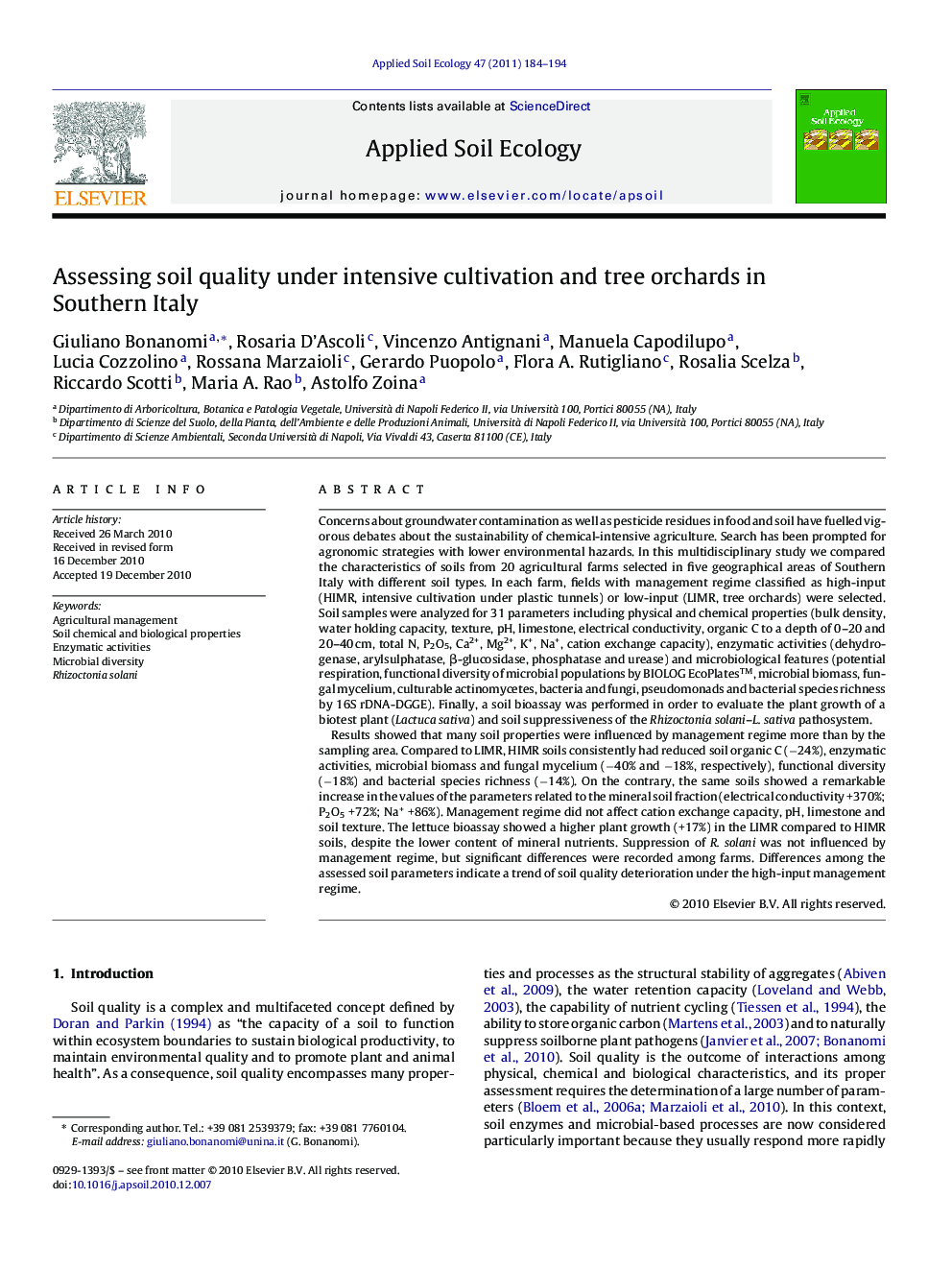| Article ID | Journal | Published Year | Pages | File Type |
|---|---|---|---|---|
| 4382749 | Applied Soil Ecology | 2011 | 11 Pages |
Concerns about groundwater contamination as well as pesticide residues in food and soil have fuelled vigorous debates about the sustainability of chemical-intensive agriculture. Search has been prompted for agronomic strategies with lower environmental hazards. In this multidisciplinary study we compared the characteristics of soils from 20 agricultural farms selected in five geographical areas of Southern Italy with different soil types. In each farm, fields with management regime classified as high-input (HIMR, intensive cultivation under plastic tunnels) or low-input (LIMR, tree orchards) were selected. Soil samples were analyzed for 31 parameters including physical and chemical properties (bulk density, water holding capacity, texture, pH, limestone, electrical conductivity, organic C to a depth of 0–20 and 20–40 cm, total N, P2O5, Ca2+, Mg2+, K+, Na+, cation exchange capacity), enzymatic activities (dehydrogenase, arylsulphatase, β-glucosidase, phosphatase and urease) and microbiological features (potential respiration, functional diversity of microbial populations by BIOLOG EcoPlates™, microbial biomass, fungal mycelium, culturable actinomycetes, bacteria and fungi, pseudomonads and bacterial species richness by 16S rDNA-DGGE). Finally, a soil bioassay was performed in order to evaluate the plant growth of a biotest plant (Lactuca sativa) and soil suppressiveness of the Rhizoctonia solani–L. sativa pathosystem.Results showed that many soil properties were influenced by management regime more than by the sampling area. Compared to LIMR, HIMR soils consistently had reduced soil organic C (−24%), enzymatic activities, microbial biomass and fungal mycelium (−40% and −18%, respectively), functional diversity (−18%) and bacterial species richness (−14%). On the contrary, the same soils showed a remarkable increase in the values of the parameters related to the mineral soil fraction (electrical conductivity +370%; P2O5 +72%; Na+ +86%). Management regime did not affect cation exchange capacity, pH, limestone and soil texture. The lettuce bioassay showed a higher plant growth (+17%) in the LIMR compared to HIMR soils, despite the lower content of mineral nutrients. Suppression of R. solani was not influenced by management regime, but significant differences were recorded among farms. Differences among the assessed soil parameters indicate a trend of soil quality deterioration under the high-input management regime.
Graphical abstractThe impact on soil quality of low-input (LIMR: tree orchards, above) and high-input management regime (HIMR: intensive cultivation under plastic tunnels, below) was assessed. HIMR negatively affected soil organic C, enzymatic activities, microbial biomass, functional and bacterial diversity in addition to increase electrical conductivity and Na+ content. Differences among HIMR and LIMR indicated a trend of soil quality deterioration under intensive cultivation.Figure optionsDownload full-size imageDownload as PowerPoint slideResearch highlights▶ We assessed the impact of high and low-input management (HIMR-LIMR) on soil quality. ▶ HIMR soil has lower soil organic C and enzymatic activities. ▶ HIMR negatively affects microbial biomass, functional and bacterial diversity. ▶ HIMR soil has also higher electrical conductivity and Na+ content. ▶ Differences among HIMR and LIMR indicate a trend of soil quality deterioration.
